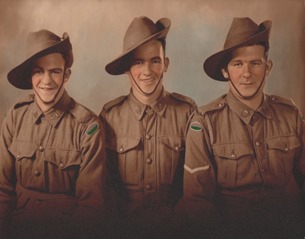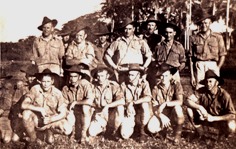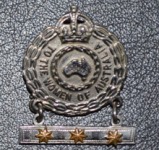

The three Turner Boys were inseparable from birth. Despite their seven years of difference, (Sidney born in 1915, Dudley in 1919, and Daryl in 1922), there are few photos that do not contain all three.
As they each left school they developed their own particular skills, Sid travelling NSW, Dudley venturing seasonally to their grandparent’s farm working as a shearer, and Daryl leaving (school in early 1940) to briefly work as a clerk in Sydney. But other than travelling for work, they only ever lived at home with their parents and 2 sisters.
Sidney (Sid) Stewart was a ‘traveller’ (a salesman by today’s terminology). He was a ‘Lady’s Man’ who could mix it with the best, and he once fought the famous American wrestler, Chief Little Wolf on the ‘travelling tent circuit’. He was the oldest of the boys and definitely the ‘alpha male’.
Dudley (Dud) James was the ‘runt of the litter’, loved a drink and a laugh and a fight, if his broken nose tells anything of his past exploits.
Daryl (Dal) George was ‘the kid’, the pretty boy that everybody loved and protected.
Sid and Dud were keen to sign up at the commencement of hostilities with Germany in September of 1939, but with Dal barely 17 and just out of at school, no one would take on Mum. And no one was going anywhere without Dal.
By June 1940 and with their father’s knowledge (if not support – “so long as all three boys stayed together”), a plan to enlist was hatched whereby both Dal and Dud would ‘change’ their birth dates (Dud needed to change his or Dal’s would have conflicted). Enlistment was easy.
The three boys enlisted 10 July 1940 with sequential serial numbers and assigned to the same Battalion. Dal was still only 17. Their mother found out a week later when they arrived home in uniform: it was not a happy house that night.
They were assigned as ‘Day Boys’, which meant they trained by day but went home at night. There were also extended training camps at various locations including Wallgrove, Castlereagh and Rutherglen, but it was an exercise at Dubbo that was to change their lives. There was a call for volunteers for ‘a special assignment‘. All three volunteered immediately.
Soon after their return to Sydney from Dubbo, they received confirmation of their acceptance to the special taskforce. Travelling to Wilson’s Promontory in May of 1941 they commenced intensive training in Australia’s first commando group, soon to be known as ‘The 1st Independent Company’. As the name implies they were independent of any other military groups and were structured with much simpler chains of command. Contrary to some misconceptions, 1st Independent Company (as the name implies), was not part of Lark Force, or any other group.
With their training in Victoria finished, they returned by train to Sydney for leave before deployment. They were not told were they were destined for, but common belief was a quick operation behind German lines before returning home in a few months.
The Troopship Zealander departed Sydney Harbour on 12 July 1941, with the three Turner Boys and the rest of 1st Independent, but it was still not till the ship left Brisbane on 15 July 1941 that their final destination was revealed: Kavieng, a small native town on the Archipelago of New Ireland and part of New Guinea, some 8,000 miles short of German ravished Europe.
What they expected was action: what they got was idyllic paradise. Kavieng had an airstrip and it appears the authorities considered the airstrip in need of protection from potential German invasion. There was no war with Japan, so other than monitoring Kavieng and a number of nearby islands on the premise of an unlikely German invasion, there was nothing to but swim, fish, hunt and take in the local scenery and culture.
1st Independent Company was here split into nine Sections (the boys all being allocated to Section 9). Some sections then deployed to nearby islands for a period of up to two months, before being relieved by the next section in rotation. This served to both relieve overcrowding and monitor for any more remote German military activity.
It was this rotation that was to determine the fate of each member by where their Section was stationed when things turned bad.
After their first month at Kavieng, the boys section was shipped to Buka, remaining there for two months before being relieved by the next section and returning to Kavieng in late October 1941.
All changed with Japan’s attack on Pearl Harbour in December 1941. We were now at war with Japan and despite their obvious and imminent movement south, 1st Independent Company was instructed to remain in place, without any increased support and not much more than few light artillery guns to fend off attack.
When the invasion of Kavieng finally did come on 21 January 1942, some 5000 heavily armed and sea battery backed Japanese infantry overran the beach and then the town at Kavieng. The 140 odd Australians currently stationed in Kavieng were no match.
With defeat eminent, the order was given to blow the fuel dump, destroy the airstrip and evacuate to the other side of the island. After executing the demolition orders, the surviving members of the Company evacuated to the western island village of Kaut. There, they subsequently and boarded their support vessel, a seconded sailing schooner, Induna Star, with intentions of sailing to Rabaul and join the Allied Forces there.
The rest of the boy’s story becomes simplified and known by most of us:
- Rabaul had already been occupied by the Japanese.
- The Induna Star was fired upon, then intercepted and escorted to Rabaul where the surviving members of 1st Independent Company were interned as Prisoners of War, (along with most of the 2/22 Battalion).
- On 22 June 1942 nearly all surviving non-commissioned Prisoners of War held in Rabaul, including the Turner Boys were loaded on the Montevideo Maru for transportation to Japanese occupied China.
- On 1 July 1942 the unmarked Montevideo Maru was torpedoed by the USS Sturgeon, the result being the loss of all 1,053 Australian solders, civilians and merchant sailors on board.
The boy’s story ended there, but the family’s story seemed to also stop then.
For the next 3½ years the family went into a kind of suspended animation, praying for the best but fearing the worst.
In early October 1945, some 2 months after the war ended, the Salvation Army arrived at the home of Jesse and Mark Turner to tell them their three sons would not be coming home. They were officially notified by the Government some four weeks later.
They also received the three standard ‘condolence’ printed cards from King George—in one envelope.
Mark withdrew and lived a quiet live. He had abandoned his ‘catholic’ family to marry ‘protestant’ Jesse some 30 years before. He had no one left other than his wife and 2 daughters for support.
Alexis, their oldest daughter (my grandmother), also lost her husband, due to war injuries, never remarried and became a recluse, living next door to her parents.
Ona, the youngest of the 5 children never married, and never left her parents’ home.
The Turners side of our family never really existed after the war and due to the death of the three boys (the only males), and Mark’s isolation from his family, this Turner Family line ended.
The Turners now only live on in our memories.
|
|
|


